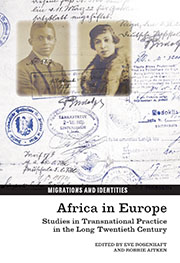Book contents
- Frontmatter
- Contents
- Acknowledgements
- List of Illustrations
- List of Abbreviations
- List of Contributors
- 1 Introduction
- I Enacting Identity: Individuals, Families and Communities
- 2 Prince Dido of Didotown and ‘Human Zoos’ in Wilhelmine Germany: Strategies for Self-Representation under the Othering Gaze
- 3 Schwarze Schmach and métissages contemporains: The Politics and Poetics of Mixed Marriage in a Refugee Family
- 4 ‘Among them Complicit’? Life and Politics in France's Black Communities, 1919–1939
- 5 ‘In this Metropolis of the World We Must Have a Building Worthy of Our Great People’: Race, Empire and Hospitality in Imperial London, 1931–1948
- II Authenticity and Influence: Contexts for Black Cultural Production
- III Post-colonial Belonging
- IV Narratives/Histories
- Bibliography
- Index
2 - Prince Dido of Didotown and ‘Human Zoos’ in Wilhelmine Germany: Strategies for Self-Representation under the Othering Gaze
from I - Enacting Identity: Individuals, Families and Communities
- Frontmatter
- Contents
- Acknowledgements
- List of Illustrations
- List of Abbreviations
- List of Contributors
- 1 Introduction
- I Enacting Identity: Individuals, Families and Communities
- 2 Prince Dido of Didotown and ‘Human Zoos’ in Wilhelmine Germany: Strategies for Self-Representation under the Othering Gaze
- 3 Schwarze Schmach and métissages contemporains: The Politics and Poetics of Mixed Marriage in a Refugee Family
- 4 ‘Among them Complicit’? Life and Politics in France's Black Communities, 1919–1939
- 5 ‘In this Metropolis of the World We Must Have a Building Worthy of Our Great People’: Race, Empire and Hospitality in Imperial London, 1931–1948
- II Authenticity and Influence: Contexts for Black Cultural Production
- III Post-colonial Belonging
- IV Narratives/Histories
- Bibliography
- Index
Summary
Participation in ethnographic exhibitions or ‘human zoos’ can be counted among the many vehicles for transnational mobility around the turn of the twentieth century. Such exhibitions offered a European audience the chance to experience contact with non-Europeans up close and to learn more about them and their cultures. There were also advantages to be gained by the non-European participants. For some of them, able to draw on a cosmopolitan experience and a transnational perspective on the world, ethnographic exhibitions presented an opportunity to stage their own personalities for a European audience through practices of self-representation. This chapter proposes that one of those participants, the Cameroonian Prince Samson Dido of Douala, who visited Imperial Germany in 1886, can be seen as a cultural hybrid in the sense in which the term is used by the postcolonial theorist Homi K. Bhabha. It explores the possibilities and limits of self-representation implicit in that condition and in the cultural practices of the period.
Dido was an African by colour, a Duala notable through his cultural background and his everyday practices, and a German above all through his love of German aristocratic forms of dress. This in turn made him a middle-man, or rather a ‘mimic man’, of the Germans, who had become the colonial rulers of Cameroon in 1884. His experience thus exemplifies the way in which colonial subjects show themselves to be good collaborators in the colonial project through their tendency to imitate the colonisers and their culture.
- Type
- Chapter
- Information
- Africa in EuropeStudies in Transnational Practice in the Long Twentieth Century, pp. 19 - 33Publisher: Liverpool University PressPrint publication year: 2013

